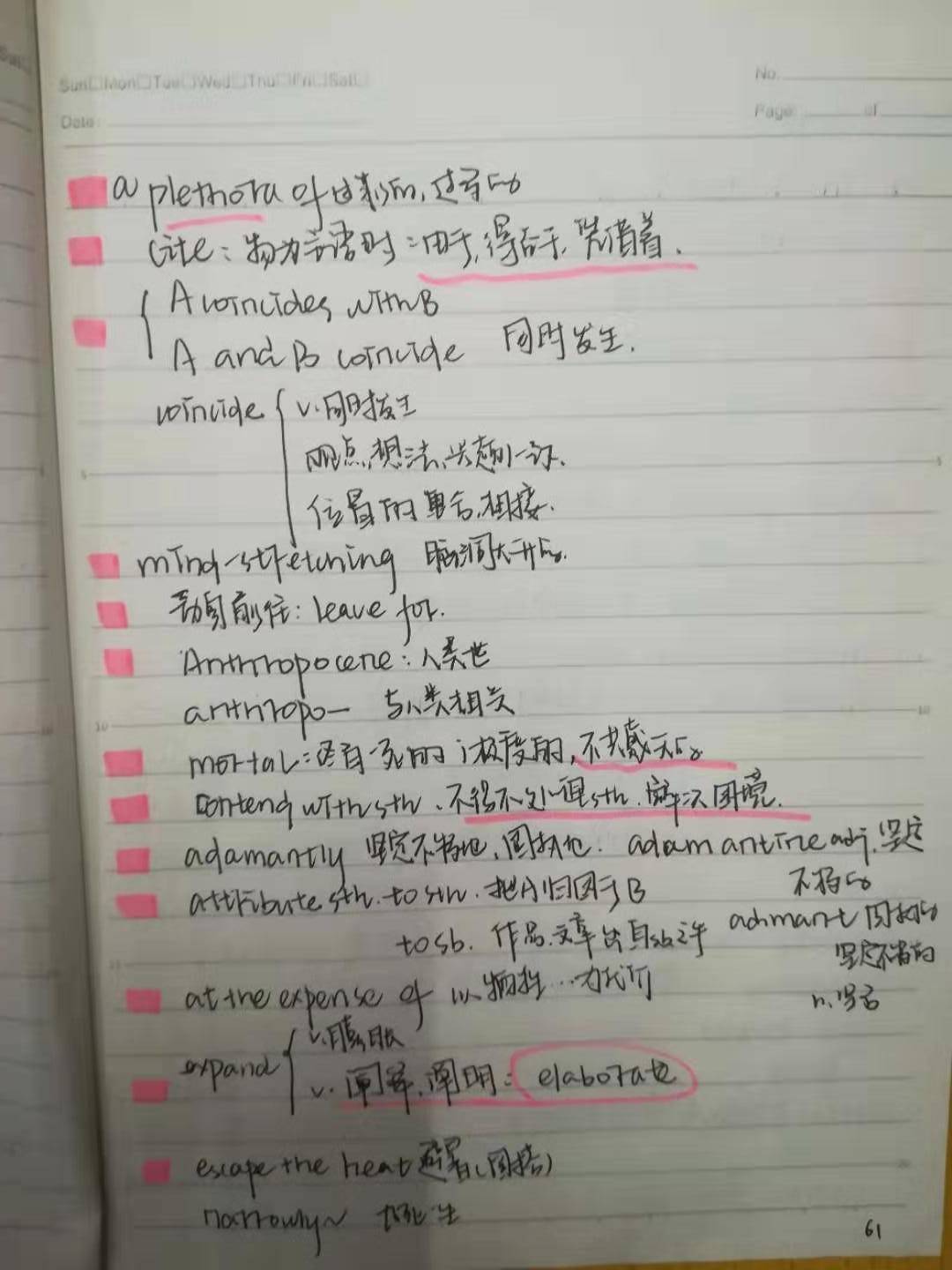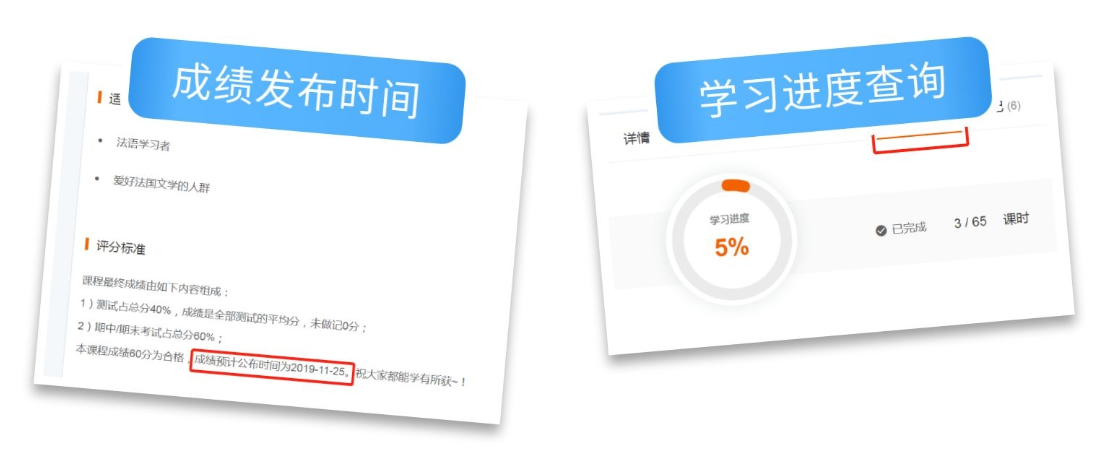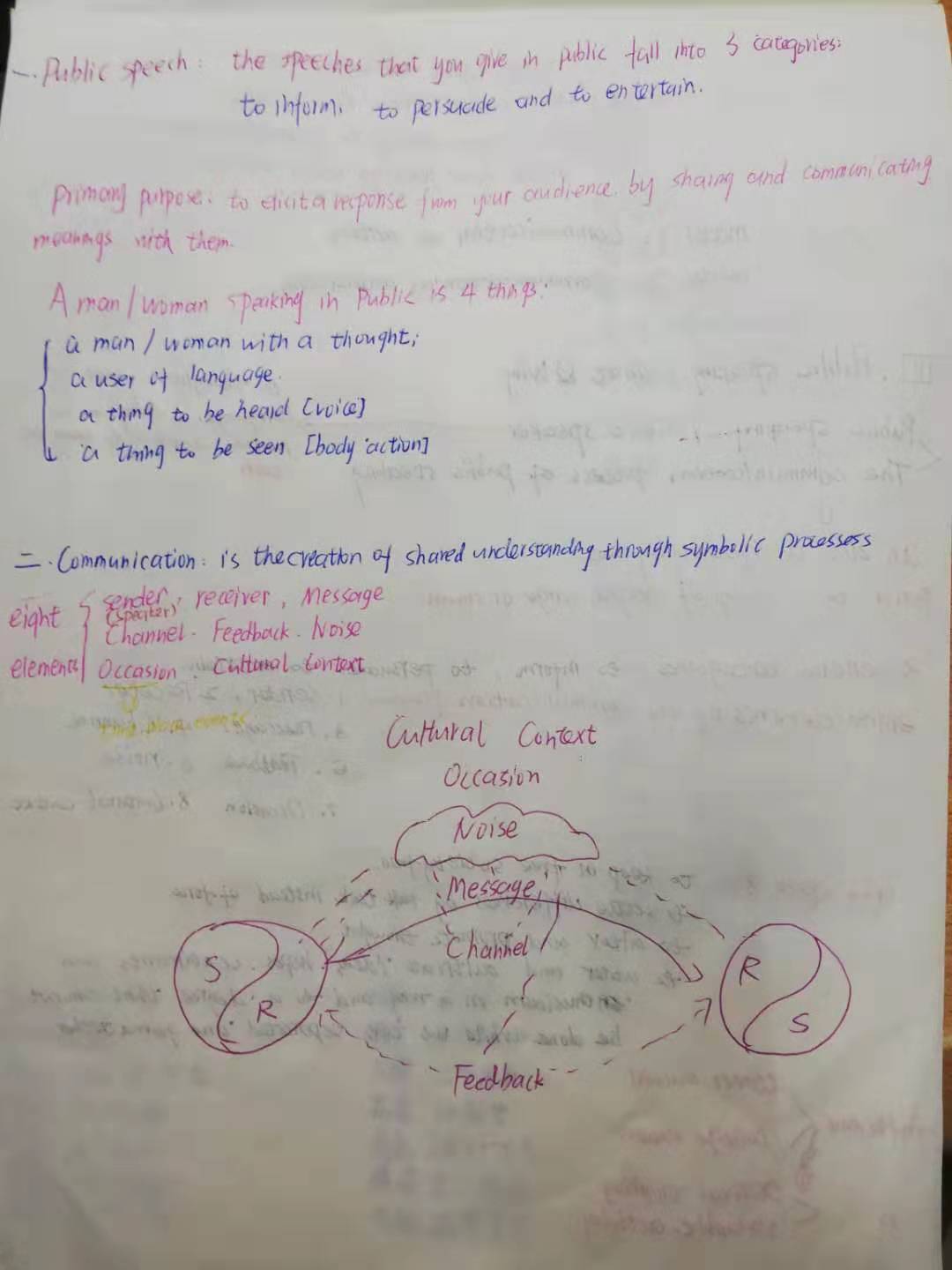19年接近尾声,我们的课程也临近结课。相信在学习过程中,你的笔记本一定增加了很多内容,那些语法、单词、知识点,求分享求展示呀~揭开幕布,你就会发现身边俱是道友哦~
【参与方式】
· 我需要做什么?
Step 1 在本帖下回复课程笔记,笔记形式:文字、图片…...笔记太多装不下?那网盘链接也可以呀~

Step 2 学习课程,达到课程合格成绩。(大家可关注成绩发布时间,成绩发布前努力提高学习进度叭)

【奖励规则】
活动时间:12月2日-12月31日
回帖数量达30帖,课程证书将由普通证书升级为教师签名版高光认证证书,成绩发布后合格学员即可下载啦。
(ps. 证书还可以分享至领英,助你成为职场+外语领域最靓的崽~)
教师签名版高光认证证书↓:

43 回复
-

-


-


-

-

How to prepare for Q-A:
1. Formulate answers to possible questions
Think about any possible questions that may be asked
about your speech.
Ask your friends, family, teachers to raise questions inrelation to your speech
Keep track of all questions
Take time to formulate answers to these questions
Expecting questions: if your speech is a persuasive oneit is likely for you to receive questions of objections; Ifyour speech is a technical and informative one, you may receive questions asking for clarification
-

Public speaking is more official the daily conversation.
Beautiful prounounciation and beatiful ideas are both important in public speaking. However, as far as I am concerned, beautiful pronounciation is the basis for audiences to understand you and enjoy your performances which is easily arouse the audiences'interest. Beautiful ides is the higher request and should be based on beautiful pronounciation.
freedback is the effective way for you to improve yourself and help you to perform better next time. -

Types of Credibility
Inial credibility: the credibility of the speakerbefore she or he starts to speak.
Derived credibility: the credibility of the speaker produced by everything she or he says and does during the speech itself.
Terminal credibility: the credibility of thespeaker at the end of the speech. -

To overcome the fear 4 keypoints:
Believe that nervousness is normal, orinsome situations, positive.Know that most nervousness is not visibleand your audience may notknow.Don't expect perfection.
Realization: audiences may notknowUnderstanding: preparation helpsBe at your best physically and mentally.Tighten and then relax yourleg muscle.Takea couple slow deepbreaths.
Concentrate on communicating with your
-

Environmental Analysis_
Environmental Analysis is nding out things likethe seang arrangement, the number of peoplelikely to aend, and the room lighng.
The way the seats are arranged will affect the
audience's response.It is also important to know how manypeople will be there for the speech.
The seang arrangement, the number of peopleand the room lighng are all factors that willaffect the speech.
-

-

How to use language?
1) Use language accurately
2) Use language clearly : use familiar words, use concrete words, don't pile up words with concepts. eliminate clutter
3) Use language vividly: imaginary and vivid
Increase rythm: parallelism, repetition, alliteration/antithesis
Parallelism:
I speak as a Republican. I speak as a women. I speak as a United States Senator. I speak as an American.
repetition:
if not now, when? if not us, who? if not togther, who?
alliteration:
Peace is essential for progress, but progress is no less essential for peace.
antithesis:
Ask not what your country can do for you; ask what you can do for your country.
Let us never negotiate out of fear. But let us never fear to negotiate.
-

To be audience-centered, you should keep several questions in mind when you work on your speeches;
(1)To whom am I speaking?
(2)What do I want them to know, believe, or do as a result of my speech?
(3)What is the most effective way of composing and presenting my speech to accomplish that aim?
-

-

-

Persuasive speech
---Speaking to persuade
I. The psychology of persuasion
II. The challenge of Persuasive Speaking
III. Persuasive speeches on questions of factII. Genetically engineered crops will create health problems by introducing harmful toxins and allergens into foods without the knowledge of consumers.
IV. Persuasive speeches on questions of value
V. Persuasive speeches on questions of policy
-

Persuasive speeches on questions of fact
Specific purpose: To persuade my audience that genetically engineered crops pose serious dangers to the environment and to human health
Central idea: Genetically engineered crops have the potential to create major environmental and health hazards.
Main points:I.. Genetically engineered crops will create environmental havoc by harming beneficial insects while creating superbugs and superweeds that will be very difficult to control.
II. Genetically engineered crops will create health problems by introducing harmful toxins and allergens into foods without the knowledge of consumers.
-

-

Persuasive speech
II. Bicycle riding meets all these standards for an ideal form of land transportation.
A. Bicycle riding is faster than walking or running.
B. Bicycle riding does not exploit the labor of animals or of other people.
C. Bicycle riding is not a source of air, land, water, or noise pollution.
D. Bicycle riding is extremely beneficial for the health of the rider.
-

-

The sequence has five steps that follow the psychology of persuasion:
1. Attention. First you gain the attention of your audience. You do this in the introduction by using one or more the methods described before: relating to the audience, showing the importance of the topic, making a startling statement, arousing curiosity or suspense, posing a question, telling a dramatic story, or using visual aids.
-

2. Need. Having captured the interest of your audience, you next make them feel a need for change. You show there is a serious problem with the existing situation. It is important to state the need clearly and to illustrate it with strong supporting materials---statistics, examples, and testimony—that relate directly to the audience’s values or vital interests. By the end of this step they are psychologically primed to hear your solution.
-

-

4. Visualization. Having given your plan, you intensify desire for it by visualizing its benefits. They key to this step is using vivid imagery to show your listeners how they will profit from your policy. Make them see how much better conditions will be once your plan is adopted.
-

5. Action. Once the audience is convinced your policy is beneficial, you are ready to call for action. Say exactly what you want the audience to do---and how to do it. Then conclude with a final stirring appeal that reinforces their commitment to act. A lot of commercial follow this guide, next you watch TV, keep an eye for it.
-

Informative speech
Supporting your ideas
I.Example
Tips for using examples1. Use examples to clarify your ideas
2. Use examples to reinforce your ideas
3. Use examples to personalize your ideas
II. Testimony
Testimony ---quotations or paraphrases used to support a point.
A.Expert testimony
B.Peer Testimony -

-

The conclusion
1. Signal the end of the speech
Even in casual conversation you expect some signal that the talk is coming to an end. You are taken back when the person you are talking with suddenly walks off without warning. The same is true of speechmaking. Too sudden an ending leaves the audience puzzled and unfulfilled.
How do you let your audience know your speech is ending? One way is through what you say, “In conclusion”, “One last thought”, “In closing”, “My purpose has been”, “Let me end by saying”---these are all brief hints that you are getting ready to stop.
-

-

Tips for preparing the conclusion
1. As with the introduction, keep an aye out for possible concluding materials as you research and develop the speech.
2. Conclude with a bang, not a whimper. Be creative in devising a conclusion that hits the hearts and minds of your audience. Work on several possible endings, and select the one that seems likely to have the greatest impact.
3. Do not be long-winded. The conclusion will normally make up no more than about 5 to 10 percent of your speech. Nothing aggravates audiences more than a speaker who says, “In conclusion” and then keeps on talking.
4. Don’t leave anything in your conclusion to chance. Work it out in detail, and give yourself plenty of time to practice delivering it. Many students like to write out the conclusion word for word to guarantee it is just right. If you do this, make sure you can present it smoothly, confidently, and with feeling---without relying on your notes or sounding wooden. Make your last impression as forceful and as favorable as you can.
-

添加回复
 您确定给 “0” 位老师发送协议吗?
您确定给 “0” 位老师发送协议吗?









 4008987008
4008987008